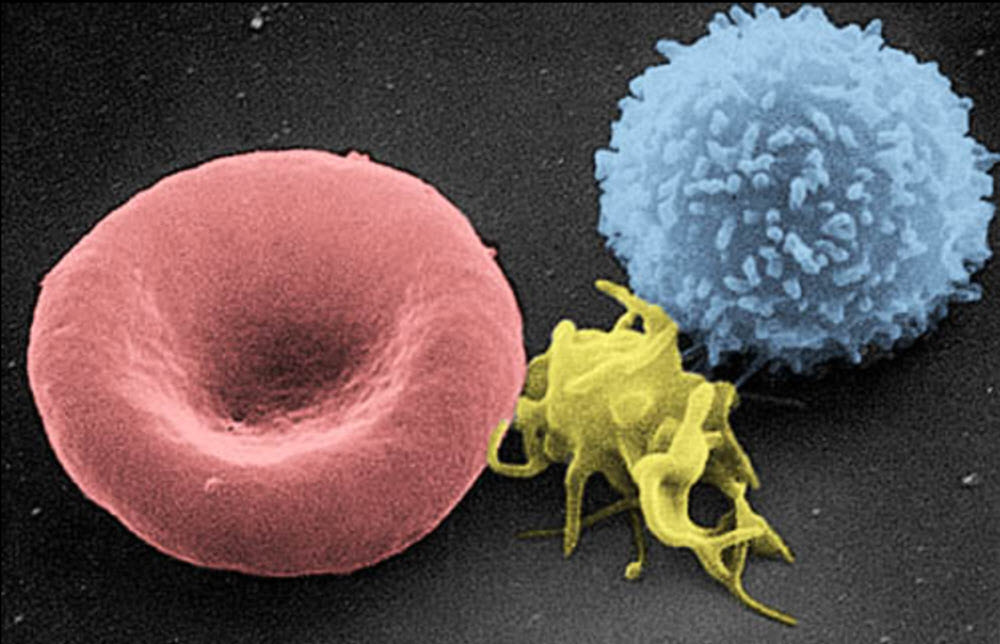Contents
Platelets, also known as thrombocytes, are an important part of the body´s system for blood coagulation. In Greek, thrombos means clot and cytos is the word for cell. When there is bleeding from a blood vessel, the platelets react by clumping together to form a blood clot. They also play a role in wound healing.
Platelets also have central roles in both innate immunity and adaptive immunity. They can initiate and participate in inflammatory processes where pathogens are bound and destroyed, and activated platelets also participate in adaptive immunity through their interaction with antibodies.

Size and shape
Inactive platelets that are circling in the blood vessels are lens-shaped and 2-3 µm in diameter.
Platelets have no cell nucleus. Instead, they are just fragments of cytoplasm.
If you look at the stained blood smear, the platelets will look like dark purple spots. The size and shape of the platelets can provide physicians with important information about a patient. Platelet testing will typically also involve checking the qualitative number of platelets and their clumping ability.
How many platelets do I have?
The number of platelets in a human can vary greatly without being indicative of any health issue, and anything between 200,000 and 500,000 per microlitre of blood is considered normal.
The average adult has roughly 10 to 20 times more red blood cells and platelets.
Production and life span
Platelets are produced in the bone marrow, and the production is regulated by thrombopoietin – a hormone produced in the liver and kidneys.
In the bone marrow, there are large cells known as megakaryocytes, and they are responsible for the production of platelets. Each megakaryocyte can produce approximately 1,000 – 3,000 platelets during its lifetime.
Reserve platelets are stored in the spleen, from which they will be released as needed.
The average lifespan of circulating platelets is just 8-9 days, before they get destroyed by phagocytosis in the liver and spleen.
Hemostasis
Hemostasis is the process of stopping bleeding at the site of injury, and being involved in hemostasis is one of the main jobs for platelets.
Platelets will gather at the site of the injury, clump together and strive to stop the bleeding. The process consists of several steps.
1.) The platelets attach to substances outside the damaged endothelium. (Endothelium is a layer of squamous endothelial cells that line the interior surface of blood vessels and lymphatic vessels.) This step is called the adhesion step.
2.) The platelets change shape, turn on receptors and begin secreting chemical messengers. This step is called the activation step.
3.) The platelets connect to each other through receptor bridges. This step of called the aggregation step.
Platelets also participate in later stages of wound healing, but are chiefly famous for their ability to quickly stop a bleeding.
What is thrombocytopenia?
An abnormally low platelet concentration is called thrombocytopenia. It is caused by decreased platelet production, increased platelet destruction, or a combination of both.
What is thrombocytosis?
An elevated platelet concentration is called thrombocytosis. It can be congential, caused by unregulated production or be reactive to cytokines.
NSAIDs and platelets
Non-steroidal anti-inflammatory drugs (NSAIDs) supress normal platelet function. This group includes several well-known medicines, such as Aspirin and Ibuprofin.
Within the NSAID groups, Aspirin is the only NSAID known to irriversibly disrupt platelet function by inhibiting the enzyme COX-1. The resulting platelets are not able to produce new COX-1, because they have no DNA. Normal platelet function will not return until the patient has stopped using aspirin and a sufficent amount of the defect platelets have been destroyed and replaced with new properly functioning ones.
One example of a NSAID with a much shorter impact on platelet function is Ibuprofen, where platelet function tends to be back to normal again within 24 ours after a dose.